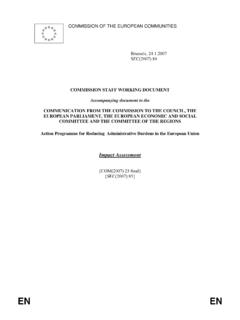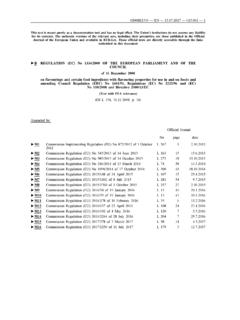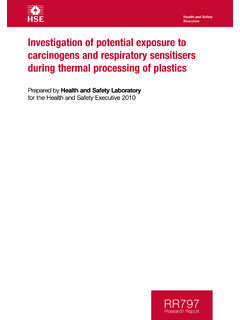Transcription of Investigation into levels of Polycyclic Aromatic ...
1 Investigation into levels of Polycyclic Aromatic Hydrocarbons (PAHs) in food on the Irish market October, 2006 2 Table of Contents 3 Abbreviations .. 4 Background .. 5 Introduction .. 5 Study Outline .. 8 9 Results .. 10 14 Appendix I .. 15 References .. 30 3 Summary The Food Safety Authority of Ireland (FSAI) has carried out a surveillance study of levels of Polycyclic Aromatic Hydrocarbons (PAHs) in a variety of foodstuffs, including chocolate, dried fruit, infant food, meat products, fish and fishery products, dietary supplements and vegetable oils. The study is the first such study carried out on Irish food, and was undertaken against the background of increased awareness in the European Union of the possible health risks, including carcinogenic effects, posed by these environmental/industrial contaminants.
2 It also reflects Ireland s participation in the 2005 EC monitoring recommendation for the background presence of PAHs in foodstuffs, which has been agreed between the European Commission and the Member States. The study has shown that levels of PAHs in products sourced on the Irish market are generally low, with the exception of a small number of food supplements, for which maximum levels have not yet been set. The lowest concentration of g/kg fresh weight for the sum total of the 15 PAHs recommended by the EU Scientific Committee on Food (referred to as SCF-15) for monitoring purposes (sum of SCF-15) was found in a sample of baby food, while, the highest level of g/kg fresh weight was found in a dietary supplement.
3 Median upper-bound levels of the sum of SCF-15 detected were as follows: chocolate and chocolate products g/kg fresh weight, dried fruit g/kg fresh weight, fats/oils g/kg fresh weight, shellfish g/kg fresh weight, smoked fish g/kg fresh weight, smoked shellfish g/kg fresh weight, infant food g/kg fresh weight, smoked meat products g/kg fresh weight and dietary supplements g/kg fresh weight. Benzo(a)pyrene (B(a)P) is currently the only PAH for which legal limits have been established under Commission Regulation 466/2001, and none of the products tested had levels of benzo(a)pyrene above these legal limits, with the exception of a small number of food supplements, for which maximum levels have not yet been set.
4 A toxicological assessment of dietary PAHs has recently been carried out by the Joint FAO/WHO Expert Committee on Food Additives (JECFA). JECFA concluded that there was a very large margin of exposure between estimated levels of dietary intake of B(a)P and the levels of B(a)P in PAH mixtures found to cause cancer. Following the findings of this survey, and taking the JECFA assessment into account, the Food Safety Authority of Ireland concludes that the levels of PAHs present in food on the Irish market are not generally of concern for human health, although the survey found high levels of PAHs including B(a)P in a small number of food supplements. The FSAI has contacted the manufacturers and suppliers of these supplements, advising them to explore the feasibility of changes to raw material sources and production processes in order to keep PAH levels in their products as low as reasonably achievable.
5 The full study report follows, providing further details and discussion of these results. 4 Abbreviations body weight congener term referring to one of many configurations of a common chemical structure EC European Community EFSA European Food Safety Authority FSAI Food Safety Authority of Ireland JECFA FAO/WHO Joint Expert Committee Food Additives/Contaminants LOD Limit of Detection Lower-bound Analytical results reported below the LOD are set at zero for calculation purposes g microgram ( g) ppb parts per billion (equal to ng/g or g/kg) SCF Scientific Committee of Food SCF-15 15 PAH congeners identified by the SCF to be genotoxic Upper-bound Analytical results reported below the LOD are set at the LOD value for calculation purposes wet weight or whole weight, equivalent to fresh weight BB body burden [BaP] benzo[a]pyrene [BaA] benz (a)
6 Anthracene [CP] cyclopenta[c,d]pyrene [CHR] chrysene [5-MC] 5-methylchrysene [BbFl] benzo[b]fluoranthene [BjFl] benzo[j]fluoranthene [BkFl] benzo[k]fluoranthene [IP] indeno[1,2,3-cd]pyrene [DBahA] dibenz[ah]anthracene [BghiPl] benzo-[g,h,i]perylene [DBalP] dibenzo[a,l]pyrene [DBaeP] dibenzo[a,e]pyrene [DBaiP] dibenzo[a,i]pyrene [DBahP] dibenzo[a,h]pyrene [ACL] acenaphthylene [AC] acenaphthene [FL] fluorene [PHE] phenanthrene [AN] anthracene [FA] fluoranthene [BcFL] benzo[c]fluorene [PY] pyrene [BghiF] benzo[ghi]fluoranthene [BNTH] benzo[b]naphtho[2,1-d]thiophene [BeP] benzo[e]pyrene [ATR] anthanthrene [COR] coronene 5 Background The Food Safety Authority of Ireland (FSAI) has a statutory responsibility to ensure the safety of food consumed, distributed, produced and sold on the Irish market.
7 In this respect, the FSAI co-ordinates the collation of food safety surveillance information from laboratories run by its official agents, the Health Service Executive (HSE), the Department of Agriculture and Food, the Department of Communication, Marine and Natural Resources, the Marine Institute and the local authorities. The FSAI also conducts targeted food safety surveillance in areas where potential safety issues have been identified and/or on food contaminants for which there are currently no testing facilities1 in Ireland, such as Multiple Polycyclic Aromatic Hydrocarbons (PAHs). This report provides the results of a surveillance study on levels of 28 different PAH congeners in a variety of products available on the Irish market.
8 This study is the first such study carried out on Irish food, and was undertaken against the background of increased awareness in the European Union of the possible health risks posed by these substances in the food chain. It also reflects Ireland s participation in the 2005 EC monitoring recommendation for the background presence of PAHs in foodstuffs which has been agreed between the European Commission and the Member States via Commission Recommendation 2005/108/EC of 4 February 2005 on the further Investigation into the levels of Polycyclic Aromatic hydrocarbons in certain foods (European Commission, 2005a). Introduction The term ' Polycyclic Aromatic hydrocarbons' commonly refers to a large class of organic compounds containing two or more fused Aromatic rings made up of carbon and hydrogen atoms.
9 Figure 1 shows the structure of benzo(a)pyrene (B(a)P), one of the best characterised members of the PAH family. The general characteristics common to the class are high melting- and boiling-points, low vapour pressure, and very low water solubility which tends to decrease with increasing molecular mass. PAHs are soluble in many organic solvents and are highly lipophilic (WHO, 1998). Hundreds of individual PAHs may be formed and released during incomplete combustion or pyrolysis of organic matter, during industrial processes and other human activities. PAHs are also formed in natural processes, such as carbonisation (Scientific Committee on Food, 2002). 1 The Public Analyst Laboratory in Dublin; Sir Patrick Dunn s, is currently developing methodology for multiple PAH analysis.
10 Analysis for benzo(a)pyrene has been available through the public analyst laboratories for a number of years. 6 Figure 1 Chemical Structure of benzo(a)pyrene Food can be contaminated by PAHs that are present in air, soil or water or are formed during processing (during drying or smoking) and cooking (during grilling, roasting or frying). Studies in experimental animals on individual PAHs, most notably benzo[a]pyrene (BaP), have shown various toxicological effects, such as haematological effects, reproductive and developmental toxicity and immunotoxicity, however, it is the carcinogenic and genotoxic potential of these compounds that has attracted most attention.















